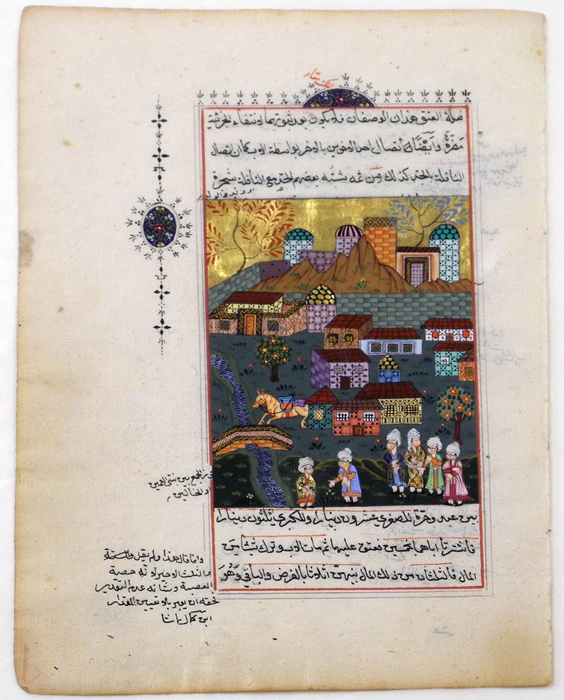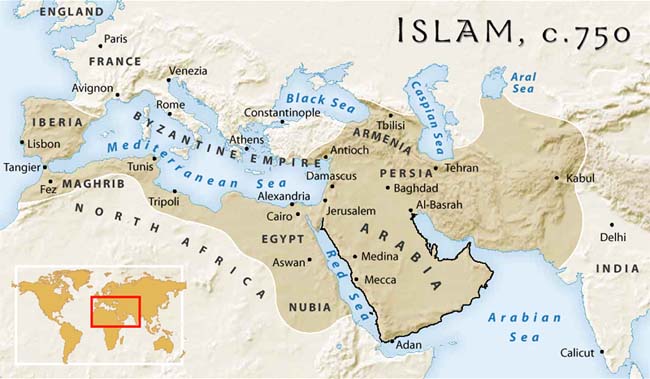Background
The religion of Islam was founded in the 7th century on the Arabian Peninsula by the prophet Muhammad (c. 570-632). It quickly spread across North Africa and into Spain, and across Persia (Iran) and into Southeast Asia. Today it is the second largest religion in the world. Islam’s holy text, the Koran (or Qur’an), the word of God given to Muhammad by the angel Gabriel, is at the heart of the religion. Also central are God (Allah), the community (Umma), and the law (Shari’a). All Muslims (followers of Islam) are further united by the Five Pillars: profession of faith, prayer, alms, fasting, and the Hajj (a pilgrimage to Mecca, Islam’s sacred city in present-day Saudi Arabia). More information
Calligraphy
Islam is a religion of the Book, revealed through the Koran. Written in Arabic (which reads from right to left), its words must be accurately preserved. The emphasis Islamic culture places on script can be seen in the calligraphy (“beautiful writing”), which is considered the highest form of art and adorns all manner of surfaces, from books to buildings, and from textiles to lamps. There are many different styles of calligraphy, from the earliest formal blocky and angular script known as Kufic, to varieties of cursive scripts. Some letters are decorated with leaves and flowers or are even made of figures.
Calligraphy may look like abstract decoration, especially if you cannot read Arabic, but the inscriptions communicate specific messages and tell stories. Since Islam encourages the study of the Koran, literacy among Muslims has been historically quite high. Calligraphers and painters collaborated to produce books on religious and secular subjects for royal and wealthy patrons, as well as libraries. Along with excerpts from the Koran, scientific, historical, and literary texts were popular. Scribes copied the texts and painters created illustrations to create illuminated manuscripts.
Ornamentation
Complex geometric designs and carefully controlled patterns of scrolling and interlacing vegetation, known as arabesques, are common in Islamic art and architecture. Such imagery developed in response to conservative Muslims’ discouragement or banning of figural representation, particularly within religious contexts. (The Koran does not forbid figural representation, but it does warn against the creation and worship of idols.) The non-representational motifs may help the faithful focus on God, rather than on the material world. Like calligraphy, abstract ornamentation can be seen on a wide variety of structures and objects.
Architecture
Islamic architecture is often distinguished by horseshoe-shaped or pointed arches. These arches are typically found palaces and in mosques, Muslims’ place of worship. All mosques are oriented toward the sacred city of Mecca. Inside, they have a mihrab (a prayer niche located on the qibla, the wall facing Mecca), a maqsura (an enclosure in front of the mihrab for the ruler and other dignitaries), a minbar (a pulpit for the prayer leader), and often a dome. Rugs are also common, as they are used while kneeling and prostrating during prayer. Outside, mosques are recognizable for their minarets (towers from which criers call believers to prayer five times per day).
For more information on and images of architecture and urbanism in the Muslim world, see archnet.org.
Questions
Look for Arabic script.
- Where on the artwork or object does the calligraphy appear?
- What is the style of the calligraphy? What does the style communicate to you?
- Do you know what the text says and/or where it comes from? Is it religious or secular?
- What is the relationship between the text and the artwork or object?
- Why do you think the artist selected the text s/he did for that particular artwork or object?
Look for ornamentation.
- What part of the surface is decorated?
- Is the design geometric or vegetal? What does the pattern communicate to you?
- What is the relationship between the surface decoration and the artwork or object?
- Why do you think the artist selected the design s/he did for that particular artwork or object?
Look for references to Islamic culture.
- Are there images of Islamic architecture? What sort of architectural structure(s) do you see?
- Was the artwork or object designed to be used in or displayed on the surface of an architectural structure? If so, what sort of building?
- Are there images of people praying, reading, or making a pilgrimage?
- Does the artwork or object remind you of any other artworks or objects that you have seen from other cultures? What might this tell you about the trade and exchange of commodities and ideas across the different cultures?
Want to know more?
Works in the Nasher’s Collection
Exhibitions at the Nasher Museum
Collecting Matisse and Modern Masters: The Cone Sisters of Baltimore (Nov. 4, 2012 – Feb. 10, 2013)
Doris Duke’s Shangri La: Architecture, Landscape, and Islamic Art (Aug. 29 – Dec. 29, 2013)
Bibliography
Traditional arts
Alt, Jennifer, ed. “Arts of the Islamic World: A Teacher’s Guide.” Washington, DC: Smithsonian Freer Gallery of Art and Arthur M. Sackler Gallery, 2002.
Azzam, Khaled, ed. Arts & Crafts of the Islamic Lands: Principles, Materials, Practice. 1st ed. London: Thames & Hudson, 2013.
Barkman, Adam. Making Sense of Islamic Art & Architecture. London: Thames & Hudson, 2015.
Blair, Sheila, and Jonathan Bloom, eds. God Is Beautiful and Loves Beauty: The Object in Islamic Art and Culture. New Haven: Yale UP, 2013.
Bloom, Jonathan, and Sheila Blair. Islamic Arts. London: Phaidon Press, 1997.
Bloom, Jonathan, and Sheila Blair. The Grove Encyclopedia of Islamic Art and Architecture. 3 vols. New York: Oxford University Press, 2009.
Broug, Eric. Islamic Geometric Design. London: Thames & Hudson, 2013.
Canby, Sheila R. Persian Painting. New York: Thames and Hudson, 1993.
Daftari, Fereshteh, ed. Without Boundary: Seventeen Ways of Looking. Exh. cat. New York: Museum of Modern Art, 2005.
Denny, Walter. “Islamic Art.” In Oxford Bibliographies in Islamic Studies.
Doris Duke Charitable Foundation. “Islamic Art Resources.” 2010. .
Eigner, Saeb. Art of the Middle East: Modern and Contemporary Art of the Arab World and Iran. London and New York: Merrell, 2010.
Ekhtiar, Maryam D., and Claire Moore, eds. Art of the Islamic World: A Resource for Educators. New York: The Metropolitan Museum of Art, 2012.
Evans, Helen C., ed. Age of Transition: Byzantine Culture in the Islamic World. New York: The Metropolitan Museum of Art; New Haven: Yale University Press, 2015.
Gillow, John. Textiles of the Islamic World. London: Thames & Hudson, 2010.
Hamdouni Alami, Mohammed. The Origins of Visual Culture in the Islamic Tradition: Aesthetics, Art and Architecture in the Medieval Middle East. London: I.B. Tauris, 2015.
Hillenbrand, Robert. Islamic Art and Architecture. London: Thames & Hudson, 1999.
Irwin, Robert. Islamic Art in Context: Art, Architecture, and the Literary World. New York: Harry N. Abrams, Inc., 1997.
Junod, Benoît, Georges Khalil, Stefan Weber, and Gerhard Wolf, eds. Islamic Art and the Museum: Approaches to Art and Archeology of the Muslim World in the Twenty-first Century. London: Saqi, 2012.
Migeon, Gaston, and Henri Saladin. Art of Islam. New York: Parkstone Press International, 2009.
Parodi, Laura E., ed. The Visual World of Muslim India: The Art, Culture and Society of the Deccan in the Early Modern Era. London: I.B. Tauris, 2014.
Porter, Venetia, ed. Word into Art: Artists of the Modern Middle East. Exh. cat. London: British Museum Press, 2005.
Rosser-Owen, Mariam. Islamic Arts from Spain. London: V & A Publishing, 2010.
Soueif, Ahdaf, ed. Reflections on Islamic Art. Doha, Qatar: Museum of Islamic Art, 2011.
On the cultural exchanges between the Islamic World and Western Europe
Howard, Deborah. Venice and the East: The Impact of the Islamic World on Venetian Architecture, 1100-1500. New Haven: Yale University Press, 2000.
Mack, Rosamond. Bazaar to Piazza: Islamic Trade and Italian Art, 1300-1600. Berkeley: University of California Press, 2002.
Saliba, George, and Linda Komaroff. The Arts of Fire: Islamic Influences on Glass and Ceramics of the Italian Renaissance. Edited by Catherine Hess. Los Angeles: Getty Trust Publications, 2003.



